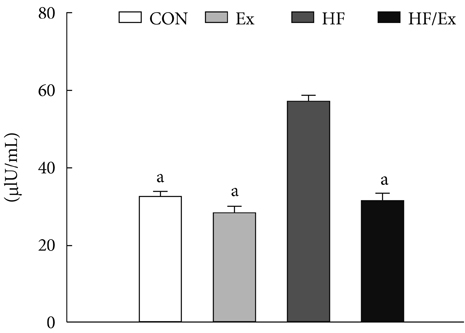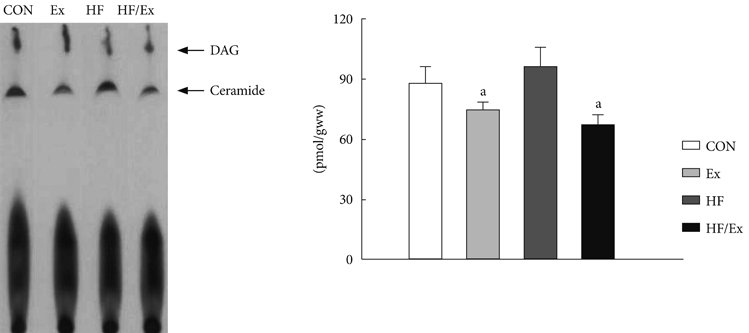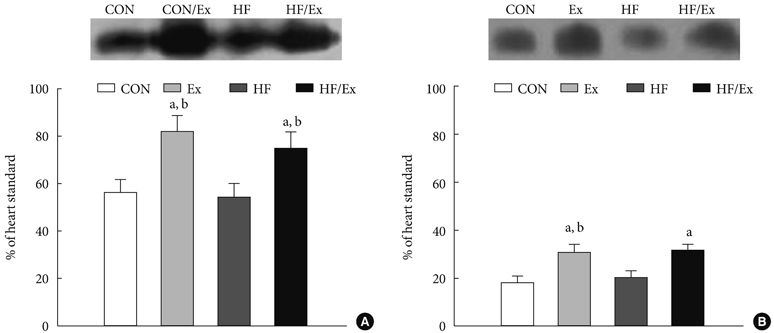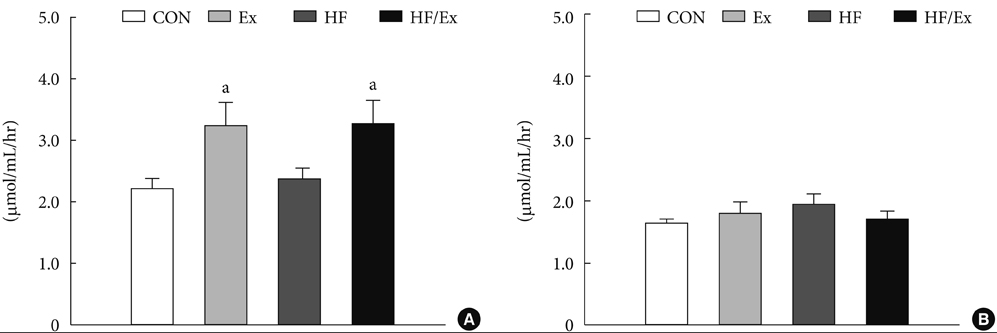Korean Diabetes J.
2010 Aug;34(4):244-252. 10.4093/kdj.2010.34.4.244.
Effects of Endurance Exercise and High-Fat Diet on Insulin Resistance and Ceramide Contents of Skeletal Muscle in Sprague-Dawley Rats
- Affiliations
-
- 1Exercise Metabolism Laboratory, Department of Physical Education, Kyungpook National University, Daegu, Korea. hokang@knu.ac.kr
- KMID: 2029878
- DOI: http://doi.org/10.4093/kdj.2010.34.4.244
Abstract
- BACKGROUND
We evaluated the effects of endurance exercise and a high-fat diet on insulin resistance and ceramide contents of skeletal muscle in Sprague-Dawley rats.
METHODS
We randomly divided 32 rats into four groups: control (CON, n = 8), high fat diet (HF, n = 8), exercise (Ex, 24 m/min for 2 hours, 5 days/wk, n = 8), HF/Ex (n = 8). After 4-week treatments, plasma lipid profiles, glucose and insulin concentrations were measured. The triglycerides (TG), ceramide, and glucose transporter 4 (GLUT-4) contents were measured in the skeletal muscle. The rate of glucose transport was determined under submaximal insulin concentration during the muscle incubation.
RESULTS
Free fatty acid levels were significantly higher in CON and HF than Ex (P = 0.032). Plasma glucose levels in HF were significantly higher than the two Ex groups (P = 0.002), and insulin levels were significantly higher in HF than in other three groups (P = 0.021). Muscular TG concentrations were significantly higher in HF than CON and Ex and also in HF/Ex than Ex, respectively (P = 0.005). Hepatic TG concentrations were significantly higher in HF than other three groups but Ex was significantly lower than HF/Ex (P = 0.000). Muscular ceramide content in HF was significantly greater than that in either Ex or HF/Ex (P = 0.031). GLUT-4 levels in CON and HF were significantly lower than those in Ex and HF/Ex (P = 0.009, P = 0.003). The glucose transport rate in submaximal insulin concentration was lower in CON than in either Ex or HF/Ex (P = 0.043), but not different from HF.
CONCLUSION
This study suggests that high fat diet for 4 weeks selectively impairs insulin resistance, but not glucose transport rate, GLUT-4 and ceramide content in skeletal muscle per se. However, endurance exercise markedly affects the content of ceramide and insulin resistance in muscle.
Keyword
MeSH Terms
Figure
Reference
-
1. Consitt LA, Bell JA, Houmard JA. Intramuscular lipid metabolism, insulin action, and obesity. IUBMB Life. 2009. 61:47–55.2. Lee JS, Pinnamaneni SK, Eo SJ, Cho IH, Pyo JH, Kim CK, Sinclair AJ, Febbraio MA, Watt MJ. Saturated, but not n-6 polyunsaturated, fatty acids induce insulin resistance: role of intramuscular accumulation of lipid metabolites. J Appl Physiol. 2006. 100:1467–1474.3. Mullen KL, Pritchard J, Ritchie I, Snook LA, Chabowski A, Bonen A, Wright D, Dyck DJ. Adiponectin resistance precedes the accumulation of skeletal muscle lipids and insulin resistance in high-fat-fed rats. Am J Physiol Regul Integr Comp Physiol. 2009. 296:R243–R251.4. Mullen KL, Smith AC, Junkin KA, Dyck DJ. Globular adiponectin resistance develops independently of impaired insulin-stimulated glucose transport in soleus muscle from high-fat-fed rats. Am J Physiol Endocrinol Metab. 2007. 293:E83–E90.5. Zderic TW, Davidson CJ, Schenk S, Byerley LO, Coyle EF. High-fat diet elevates resting intramuscular triglyceride concentration and whole body lipolysis during exercise. Am J Physiol Endocrinol Metab. 2004. 286:E217–E225.6. Delarue J, Magnan C. Free fatty acids and insulin resistance. Curr Opin Clin Nutr Metab Care. 2007. 10:142–148.7. Ohanian J, Ohanian V. Sphingolipids in mammalian cell signalling. Cell Mol Life Sci. 2001. 58:2053–2068.8. Summers SA. Ceramides in insulin resistance and lipotoxicity. Prog Lipid Res. 2006. 45:42–72.9. Chavez JA, Knotts TA, Wang LP, Li G, Dobrowsky RT, Florant GL, Summers SA. A role for ceramide, but not diacylglycerol, in the antagonism of insulin signal transduction by saturated fatty acids. J Biol Chem. 2003. 278:10297–10303.10. Powell DJ, Turban S, Gray A, Hajduch E, Hundal HS. Intracellular ceramide synthesis and protein kinase Czeta activation play an essential role in palmitate-induced insulin resistance in rat L6 skeletal muscle cells. Biochem J. 2004. 382(Pt 2):619–629.11. Shah C, Yang G, Lee I, Bielawski J, Hannun YA, Samad F. Protection from high fat diet-induced increase in ceramide in mice lacking plasminogen activator inhibitor 1. J Biol Chem. 2008. 283:13538–13548.12. Bruce CR, Thrush AB, Mertz VA, Bezaire V, Chabowski A, Heigenhauser GJ, Dyck DJ. Endurance training in obese humans improves glucose tolerance and mitochondrial fatty acid oxidation and alters muscle lipid content. Am J Physiol Endocrinol Metab. 2006. 29:E99–E107.13. Schmitz-Peiffer C, Craig DL, Biden TJ. Ceramide generation is sufficient to account for the inhibition of the insulin-stimulated PKB pathway in C2C12 skeletal muscle cells pretreated with palmitate. J Biol Chem. 1999. 274:24202–24210.14. Yu C, Chen Y, Cline GW, Zhang D, Zong H, Wang Y, Bergeron R, Kim JK, Cushman SW, Cooney GJ, Atcheson B, White MF, Kraegen EW, Shulman GI. Mechanism by which fatty acids inhibit insulin activation of insulin receptor substrate-1 (IRS-1)-associated phosphatidylinositol 3-kinase activity in muscle. J Biol Chem. 2002. 277:50230–50236.15. Dobrzyn A, Gorski J. Ceramides and sphingomyelins in skeletal muscles of the rat: content and composition. Effect of prolonged exercise. Am J Physiol Endocrinol Metab. 2002. 282:E277–E285.16. Dobrzyn A, Zendzian-Piotrowska M, Gorski J. Effect of endurance training on the sphingomyelin-signalling pathway activity in the skeletal muscles of the rat. J Physiol Pharmacol. 2004. 55:305–313.17. Helge JW, Dobrzyn A, Saltin B, Gorski J. Exercise and training effects on ceramide metabolism in human skeletal muscle. Exp Physiol. 2004. 89:119–127.18. Ivy JL. Muscle insulin resistance amended with exercise training: role of GLUT4 expression. Med Sci Sports Exerc. 2004. 36:1207–1211.19. Dobrzyn A, Gorski J. Effect of acute exercise on the content of free sphinganine and sphingosine in different skeletal muscle types of the rat. Horm Metab Res. 2002. 34:523–529.20. Noma A, Okabe H, Kita M. Determination of serum cholinesterase activity by means of automatic titration. Rinsho Byori. 1973. 21:457–460.21. Perry DK, Bielawska A, Hannun YA. Quantitative determination of ceramide using diglyceride kinase. Methods Enzymol. 2000. 312:22–31.22. Burton AF, Anderson FH. Increased cholesteryl ester content in liver of mice fed lipid emulsion diets high in polyunsaturated fats. JPEN J Parenter Enteral Nutr. 1985. 9:480–482.23. Lee JS, Bruce CR, Tunstall RJ, Cameron-Smith D, Hugel H, Hawley JA. Interaction of exercise and diet on GLUT-4 protein and gene expression in Type I and Type II rat skeletal muscle. Acta Physiol Scand. 2002. 175:37–44.24. Fisher JS, Nolte LA, Kawanaka K, Han DH, Jones TE, Holloszy JO. Glucose transport rate and glycogen synthase activity both limit skeletal muscle glycogen accumulation. Am J Physiol Endocrinol Metab. 2002. 282:E1214–E1221.25. Sherman WM, Katz AL, Cutler CL, Withers RT, Ivy JL. Glucose transport: locus of muscle insulin resistance in obese Zucker rats. Am J Physiol. 1988. 255:E374–E382.26. Willems ME, Brozinick JT Jr, Torgan CE, Cortez MY, Ivy JL. Muscle glucose uptake of obese Zucker rats trained at two different intensities. J Appl Physiol. 1991. 70:36–42.27. Safwat GM, Pisano S, D'Amore E, Borioni G, Napolitano M, Kamal AA, Ballanti P, Botham KM, Bravo E. Induction of non-alcoholic fatty liver disease and insulin resistance by feeding a high-fat diet in rats: does coenzyme Q monomethyl ether have a modulatory effect? Nutrition. 2009. 25:1157–1168.28. Silva AS, Pauli JR, Ropelle ER, Oliveira AG, Cintra DE, De Souza CT, Velloso LA, Carvalheira JB, Saad MJ. Exercise intensity, inflammatory signaling and insulin resistance in obese rats. Med Sci Sports Exerc. Epub 2010 May 13. DOI: 10.1249/MSS.0b013e3181e45d08.29. Roden M, Price TB, Perseghin G, Petersen KF, Rothman DL, Cline GW, Shulman GI. Mechanism of free fatty acid-induced insulin resistance in humans. J Clin Invest. 1996. 97:2859–2865.30. Zierath JR, Houseknecht KL, Gnudi L, Kahn BB. High-fat feeding impairs insulin-stimulated GLUT4 recruitment via an early insulin-signaling defect. Diabetes. 1997. 46:215–223.31. Rosholt MN, King PA, Horton ES. High-fat diet reduces glucose transporter responses to both insulin and exercise. Am J Physiol. 1994. 266:R95–R101.32. Kahn BB, Pedersen O. Suppression of GLUT4 expression in skeletal muscle of rats that are obese from high fat feeding but not from high carbohydrate feeding or genetic obesity. Endocrinology. 1993. 132:13–22.33. Han DH, Hansen PA, Host HH, Holloszy JO. Insulin resistance of muscle glucose transport in rats fed a high-fat diet: a reevaluation. Diabetes. 1997. 46:1761–1767.34. Gan SK, Kriketos AD, Ellis BA, Thompson CH, Kraegen EW, Chisholm DJ. Changes in aerobic capacity and visceral fat but not myocyte lipid levels predict increased insulin action after exercise in overweight and obese men. Diabetes Care. 2003. 26:1706–1713.35. Goodpaster BH, Katsiaras A, Kelley DE. Enhanced fat oxidation through physical activity is associated with improvements in insulin sensitivity in obesity. Diabetes. 2003. 52:2191–2197.36. Tanaka S, Hayashi T, Toyoda T, Hamada T, Shimizu Y, Hirata M, Ebihara K, Masuzaki H, Hosoda K, Fushiki T, Nakao K. High-fat diet impairs the effects of a single bout of endurance exercise on glucose transport and insulin sensitivity in rat skeletal muscle. Metabolism. 2007. 56:1719–1728.37. Montell E, Turini M, Marotta M, Roberts M, Noe V, Ciudad CJ, Mace K, Gomez-Foix AM. DAG accumulation from saturated fatty acids desensitizes insulin stimulation of glucose uptake in muscle cells. Am J Physiol Endocrinol Metab. 2001. 280:E229–E237.38. Baranowski M, Blachnio A, Zabielski P, Gorski J. PPARalpha agonist induces the accumulation of ceramide in the heart of rats fed high-fat diet. J Physiol Pharmacol. 2007. 58:57–72.39. Monney L, Olivier R, Otter I, Jansen B, Poirier GG, Borner C. Role of an acidic compartment in tumor-necrosis-factor-alpha-induced production of ceramide, activation of caspase-3 and apoptosis. Eur J Biochem. 1998. 251:295–303.40. Gorski J, Dobrzyn A, Zendzian-Piotrowska M. The sphingomyelin-signaling pathway in skeletal muscles and its role in regulation of glucose uptake. Ann N Y Acad Sci. 2002. 967:236–248.
- Full Text Links
- Actions
-
Cited
- CITED
-
- Close
- Share
- Similar articles
-
- Effect of Exercise Training on Insulin Sensitivity and Intracellular Glucose Metabolism in Skeletal Muscle of High Fat-fed Rats
- Effects of High Fat Diet on Lipolysis in Skeletal Muscle and Adipose Tissue in Rats
- Skeletal Muscle Mitochondria and Insulin Resistance: The Role of Exercise
- Effects of aged garlic extract and endurance exercise on skeletal muscle FNDC-5 and circulating irisin in high-fat-diet rat models
- Differential Effects of High-carbohydrate and High-fat Diet Composition on Muscle Insulin Resistance in Rats








